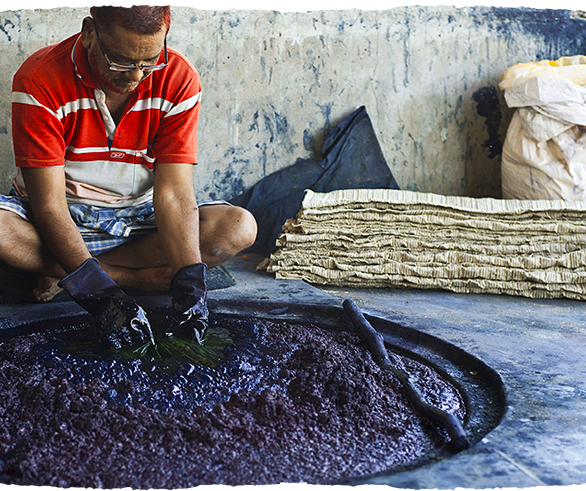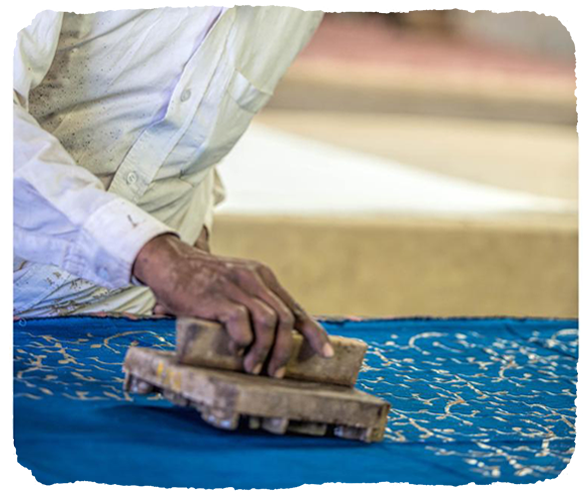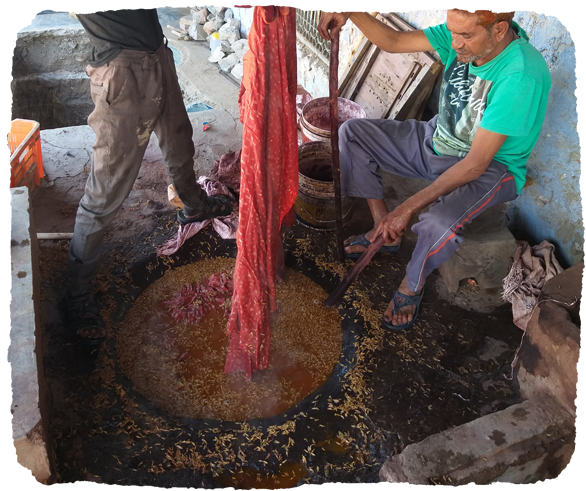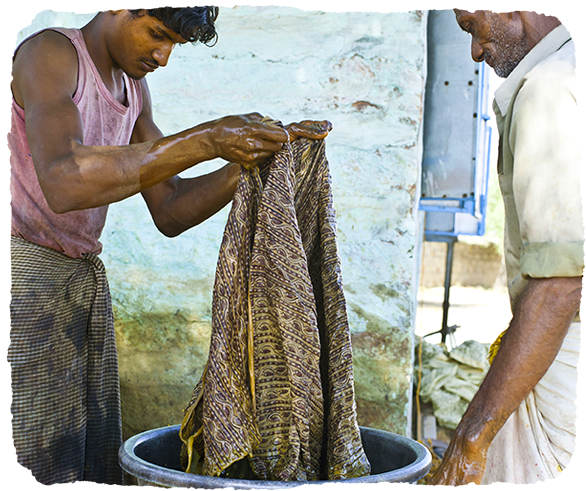Step 1: INDIGO (‘Neel Rangai’)
It is the most interesting process of coloring the fabric blue. Indigo dyeing is done in an indigo tank in which the water has not been changed since 30 years. equal quantity of indigo is to be added each time when we are dyeing. This unique color development enhances itself over these long periods. The printed cloth is folded neatly like sari pleats and lowered gently into the indigo tank. When the cloth is totally submerged in the tank, the dyer holds it under the liquid dye and opens each pleat to allow the fabric to hold the indigo dye evenly. Since indigo does not react in the presence of air, any air trapped in the folds or pleats will give “patchy” dyeing. The dyer unfolded the pleats neatly and gently to avoid cracking of ‘Dabu’. The fabric is then taken out of tank, gently squeezed and opened out to react with the atmospheric oxygen and turn the greenish indigo into oxidized indigo. Indigo has poor affinity to the fabric in the presence of water, so the first ‘more dip’ gives a pale sky blue shade. In order to get darker indigo blue, the fabric is again dipped in the tank for five minutes, pulled out and oxidized. This process is repeated till the desired dark shade is achieved. The fabric is finally dried flat on the ground. Care is taken that while dyeing or drying; ‘dabu’ does not get broken or cracked. The dried fabric is washed for two consecutive days with water to remove all mud and excess colour from fabric.

Step 2: DABU MUD RESIST PRINTING (‘Dabu Datai’)

The printers often use a unique process of discharge printing to get the white or contrast colored portions of the design. This special paste (a mixture of Kali Mitti collected from the lake beds and specially from areas where buffaloes have waded as this clay is well grounded due to their movement and weight, Gur – Jaggery, Gond – Edible gum and Chuna-lime ) technique, a specialty of traditional printing of Rajasthan, is commonly known as ‘dabu’. Dabu acts as mechanical resist and prevents the penetration of dye during dyeing on areas covered with ‘dabu’. Dabu is applied by wooden block on the fabric and saw dust is sprinkled over it. Saw dust has two major functions at this stage-first to absorb water from the Dabu paste and give extra hardness to mud. After printing, the fabric is left outside in the sun for drying before dipping in indigo or other colour. The art of making ‘dabu’ paste is kept secret and every family has its own recipe to make the paste.

Step 3: ALIZARIN DYEING (‘Ghana Rangai’)
Dyeing is a process in which the dye (Alizarin) reacts with alum giving red color. Alizarin is used as the dye throughout Rajasthan. Dyeing is carried out in large copper vessels (‘tambri’) which are heated by wood fire. Alizarin is filled in small cloth–bags (‘potali’) and dipped in the vessel.
‘Dhawadi phool’, a local flower along with Sakur (mahi)-Florin Bunda, and the fabric along with this extract is boiled at 120 degree centigrade along with alizarin to avoid patches and staining.
The fabric is then taken out of the vessel, and left on the ground for drying after washing it twice.

Step 4: POST MORDANTING WITH ALUM (‘Kocha Phitkari’)

The fabric is dipped twice in a solution of harda & dry the fabric. After drying the fabric we will dip in the alum water.
This process turns the white area over the fabric into yellow and the rest part which is covered by mud remains the same. This fabric is finally washed twice in water and dried. And thus, the fabric is converted to a beautiful, fine work of art.
